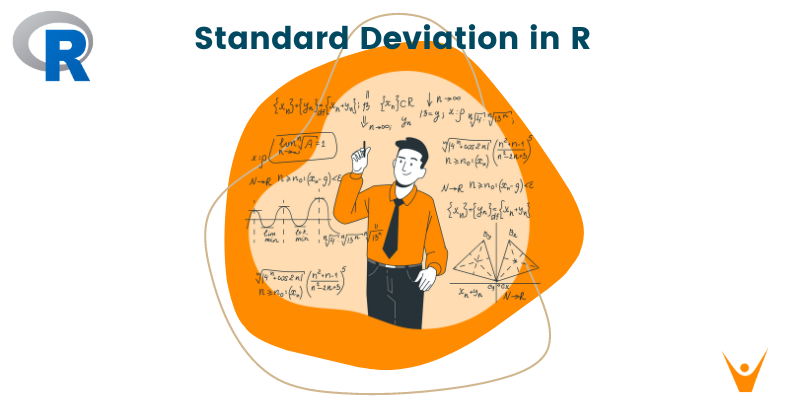Standard deviation is a crucial statistical concept with a significant impact on data analysis and decision-making. In the world of data science and statistics, the R programming language is a standout tool for computation and visualization. In this article, we'll learn in-depth about the details of standard deviation in R, covering the basics, implementing the standard deviation function, and exploring related concepts such as standard error.
What is Standard Deviation?
Before starting with functions specific to R programming, let's learn about what standard deviation is. Standard deviation is a measure of the amount of variation or dispersion in a set of values. It quantifies how much individual data points differ from the mean (average) of the dataset. In simpler terms, it provides a measure of the spread of data points around the mean.
R Standard Deviation Function
R provides a convenient function to calculate the standard deviation of a numeric vector: sd(). Let's take a closer look at how to use this function with the help of a small example.
Code:
data <- c(2, 4, 6, 8, 10) standard_deviation <- sd(data) print(paste("Standard Deviation: ", standard_deviation))
Output:
"Standard Deviation: 3.16227766016838"
In this example, we create numeric vector data and use the sd() function to calculate its standard deviation. The result is then printed to the console.
How Do You Calculate Standard Deviation in R?
The sd() function in R makes calculating standard deviation easy. Behind the scenes, this function uses the same formula we discussed earlier. It takes care of the summation, mean calculation, and square root extraction automatically.
It's important to note that the sd() function has an optional parameter called na.rm (short for "remove missing values"). If your dataset has missing values, you can set na.rm = TRUE to exclude them from the calculation.
Code:
data_with_na <- c(2, 4, NA, 8, 10) sd_with_na <- sd(data_with_na, na.rm = TRUE) print(paste("Standard Deviation (with NA removed): ", sd_with_na))
Output:
"Standard Deviation (with NA removed): 3.65148371670111"
Is Standard Error the Same as Standard Deviation in R?
While standard deviation and standard error are related concepts, they are not the same. Standard deviation quantifies the amount of variation or dispersion in a set of values, as discussed earlier. On the other hand, standard error provides a measure of the variability of sample means.
In R, if you have a dataset and wish to calculate the standard error of the mean, you can employ the se() function from the psych package. Note that this package is not part of the base R installation, so you'll need to install it first using the install.packages("psych") command.
Code:
install.packages("psych")
library(psych)
data <- c(2, 4, 6, 8, 10)
standard_error <- describe(data)$se
print(paste("Standard Error: ", standard_error))
Output:
"Standard Error: 1.4142135623731"
Standard Deviation or Standard Error - What should you Use?
The choice between standard deviation and standard error depends on the context of your analysis. Here's a brief overview of when to use each.
Standard Deviation: Use standard deviation when you want to understand the dispersion of individual data points in a dataset. It is especially useful when you are dealing with a single sample or want to analyze the variability within a dataset
Standard Error: Use standard error when you are working with sample means and want to estimate the precision of your sample mean as an estimate of the population mean. Standard error is commonly used in inferential statistics, particularly when calculating confidence intervals or conducting hypothesis tests.
To summarize, if your focus is on the variability within a dataset, use standard deviation. If you are making inferences about a population based on a sample mean, use standard error.
Why Use Standard Deviation?
Understanding why standard deviation is crucial is essential for making informed decisions in data analysis. Here are some key reasons to use standard deviation.
1. Quantifying Variability: Standard deviation provides a numerical measure of how spread out the values in a dataset are. This is valuable information for understanding the distribution of data.
2. Identifying Outliers: Large standard deviations can indicate the presence of outliers or extreme values in a dataset. Identifying and addressing outliers is crucial for ensuring the reliability of statistical analyses.
3. Comparing Datasets: Standard deviation allows for the comparison of the variability between different datasets. It helps in assessing which dataset has more consistent or stable values.
4. Risk Assessment: In finance and other fields, standard deviation is used to quantify risk. Higher standard deviations in investment returns, for example, indicate greater volatility and risk.
Manual Standard Deviation in R
While the sd() function in R handles the calculation of standard deviation, it's valuable to understand the formula for reference. In R, you can implement the standard deviation formula manually as well. It helps in editing and optimizing the formula to our needs.
Code:
manual_sd <- function(x) { n <- length(x) mean_x <- mean(x) sum_squared_diff <- sum((x - mean_x)^2) sd_value <- sqrt(sum_squared_diff / n) return(sd_value) } data <- c(2, 4, 6, 8, 10) manual_result <- manual_sd(data) print(paste("Manual Standard Deviation: ", manual_result))
Output:
"Manual Standard Deviation: 2.82842712474619"
This manual calculation function closely follows the standard deviation formula discussed earlier. It calculates the mean, the squared differences from the mean, their sum, and then takes the square root of the result.
Conclusion
This article explores standard deviation in statistical analysis using R, utilizing the convenient sd() function and manual calculations. It highlights the distinction between standard deviation and standard error, emphasizing their respective applications. Whether analyzing a single dataset or making population inferences, a solid understanding of standard deviation in R enhances the extraction of meaningful insights. It serves as a reliable tool for uncovering hidden patterns in data, making it an essential component of data science endeavors.








